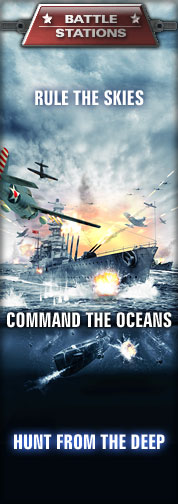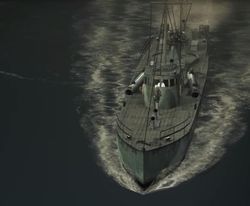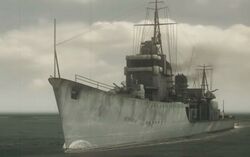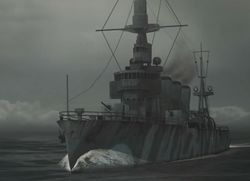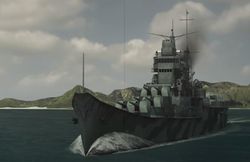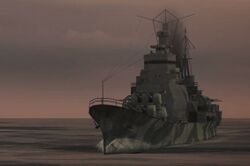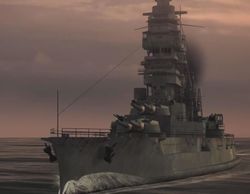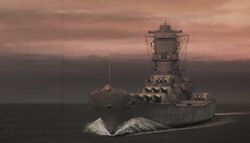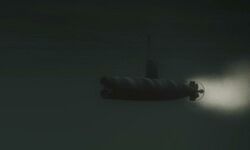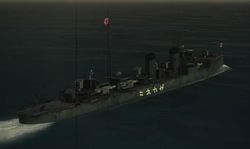The Empire of Japan represents the Axis in the Pacific, and are facing off against the United States. The Japanese have swift, powerful warships with an emphasis on torpedoes, and their air force specializes in lightly-armed but quick aircraft.
[edit]
Interestingly, some of the warships are mis-classified. The Hatsushimo, for instance, was in fact a Hatsuharu-class, not a Minekaze-class, destroyer. It can be assumed that the game designers were running low on space and therefore had to resort to mis-classifying the ships and save ship models. Additionally, due to the lack of the battlecruiser class, battlecruisers like the Kongō are simply battleships.
The Japanese typically follow abstract naming conventions when naming their ships. Destroyers, for instance, are often named after wind ("Kawakaze" means "river wind") while battlecruisers (including those remodelled into carriers) were named after mountains ("Akagi" and "Kongō" being examples) and carriers were named after flying creatures ("Hiryu" means "flying dragon"). Patrol boats were typically named after birds, but in-game they are merely numbered like their U.S counterparts ("Gyoraitei No. 4")
Playable Warships[edit]
These warships are playable either online or in the game's challenge missions. None of the Japanese units are playable in the single player campaign, since it takes the perspective of the U.S in the war for the Pacific.
Gyoraitei Patrol Boat[edit]
The Gyoraitei controls similarly to the Elco, and those with Elco experience will have few problems handling a Gyoraitei. Both have a single depth charge rack and both are too shallow to be struck with torpedoes, making both types of PT boats highly effective against enemy submarines. Both are also easily sunk with machine gun fire.
Power-wise, the two are roughly comparable. The Elco lacks the massive cannon the Gyoraitei has, making the Gyoraitei effective at longer ranges. The Gyoraitei's cannon is also a flak gun, which allows it to strike at high-flying dive bombers, whereas the Elco only sports machine guns, which lack the power and range to strike high.
The Elco, however, sports two more torpedo tubes than the Gyoraitei, making the Elco superior in attacking warships at closer ranges. The Gyoraitei's cannon is difficult to aim, especially against fast-moving surface targets, especially Elcos. This means that a typical battle between a Gyoraitei and an Elco tends to favour the Elco. The Gyoraitei's slow loading time for its cannon and single machine gun also detriments it against the Elco's fast-firing triple machine guns.
Official Description: The Japanese have a variety of small coastal vessels that provide a similar role to the U.S. Elco PT boat. The Japanese versions are not as fast or manoeuvrable as the Elco, but they do mount a 5" dual-purpose main gun that packs a punch against both air and surface targets. In addition they also mount machine guns, depth charges, and torpedoes, meaning they can pose a threat to any target.
Fubuki-class[edit]
The Fubuki-class is similar in many respects to the Fletcher-class. Its dual-purpose guns can easily switch between heavier shells for engaging enemy warships to lighter, air-bursting flak shells for engaging high-flying enemy aircraft, making it a jack-of-all-trades.
Its main weakness are its firing arcs - there are very few cannons able to strike from the bow of the ship. When commanding a Fubuki-class, always try and make broadside attacks to bring the most cannons to bear on an enemy. Like all destroyers, it is quite strong in an anti-submarine role.
Notable ships of this class include the Akebono, Akigumo, Amagiri, Arashi, Hamakaze, and the Natsushio.
Official Description: The Fubuki-class was the first modern destroyer design. Entering service in 1928, her twin 5" mounts located in enclosed turrets and her triple torpedo launchers gave her firepower far greater firepower than any other ship of her size at the time. Since then, other destroyer designs have appeared that can match the Fubuki-class, most notably the American Fletcher-class. Nevertheless, these are still versatile and useful ships, and their dual-purpose 5" guns give them a potent defence against attacking aircraft.
Shimakaze-class[edit]
The Shimakaze is a rarely seen unit, but it is also an extremely powerful destroyer design. Like the Fletcher-class, it shines well in any kind of role, particularly that of anti-aircraft, given its six dual-purpose guns and nice amounts of machine guns. It is, in fact, almost identical to the Fubuki-class in terms of power and cannon fire arcs. It is, however, without a doubt the fastest destroyer in the game, sailing at a lightning-fast 45 knots; just 5 knots slower than a PT boat. This speed can allow it to intercept enemy submarines before they can make any attacks on battleships.
The only two ships of this class that appear are the Kishinami and the Hayanami, featured in the multiplayer map Battle of Sibuyan Sea.
Official Description: The Shimakaze is one of the largest and most powerful destroyer in the Japanese arsenal. In addition to their heavy weaponry and large number of torpedoes, the ship has a large high-pressure and high temperature steam engine, capable of reaching extremely high speeds. This super-destroyer is the second-fastest sea unit at these times, being only slightly slower than the patrol boats, and she can easily escape from torpedoes and bombs in the hands of a skilled captain. The ship lacks armour, similar to the other destroyers, but it can quickly chase down all other combatants.
Kuma-class[edit]
The Kuma is a relatively powerful ship-to-ship combatant, but it is completely useless in the AA role, with only four machine guns - two to port, two to starboard - to provide AA fire. While it is infamous for its lack of AA weapons, this does not detriment it very much. The only map where its lack of AA may be called into question is Coral Sea.
What hinders the Kuma the most, however, is the lack of attacking power on its cannons. Its guns are identical in all respects to the Fubuki-class except it lacks the ability to target aircraft. This makes the Kuma-class the weakest cruiser in the game - perhaps the only thing saving it is its heavy armour, which prevents destroyers from causing large amounts of damage to it.
Somewhat redeeming the ship are the powerful torpedo launchers. Being reasonably fast, it can try to close the distance with an enemy warship and unleash volleys of torpedoes at point-blank range - however, the torpedoes are arranged awkwardly - one at the very front and one at the very back. As such, one of the torpedo launchers will often miss, especially if the target is coming head-on. It also sports only 8 tubes in 4 launchers, two each to port and starboard.
It is woefully behind when compared to the Cleveland and Atlanta class light cruisers, and should stick to fighting destroyers.
Notable vessels of this class include the Kiso, Kitikami, Nagara, Naka, and the Kako.
Official Description: These light cruisers are rather old now, having joined the IJN in the early 1920s. They are somewhat obsolete, and this is especially noticeable in the small number of AA guns they carry, which makes them particularly vulnerable to air attack. Nevertheless, the 5.5" guns they carry fire a heavier shell than the U.S. 5" guns, which gives them an edge when battling other light cruisers or destroyers. They also carry a good number of torpedo launchers for engaging larger ships.
Mogami Class[edit]
The Mogami-class sports a powerful weapons arrangement that makes them a threat to all targets, but its lack of wide sonar coverage, coupled with lack of depth charges, makes this warship quite vulnerable to submarine attacks. A jack-of-all-trades, the Mogami-class has no primary weaknesses, although it is far from invincible.
The Northampton-class' weapons are slightly better than the Mogami's, but one advantage the Mogami has is not only more barrels to fire from (which equals more shells) but also more turrets to fire from - and more turrets to disable for an enemy. The Northampton only has three triple-barreled turrets, so only three must go offline in order for the enemy to attack without fear of retaliation.
The Mogami, unlike the USN cruisers, sport torpedoes. This gives it an edge against larger targets while using its already powerful cannons to aid it in this endeavour. If it can get close to an enemy battleship, it can seriously wreak havoc.
Notable warships of this class include its pathfinder - the Mogami - as well as the Kumano and the Mikuma.
Official Description: These heavy cruisers were built in the mid-1930s and were in gross violation of the London Naval Treaty, which specified maximum tonnage of 10,000 for any new heavy cruisers. They have recently been refitted with 8" guns, giving them a hefty broadside that is a threat to any ship smaller than a battleship. They also mount a respectable AA battery and two torpedo launchers on each side, making them versatile and powerful warships.
Takao Class[edit]
These ships are pretty much identical in all respects to the Mogami-class, down to the armament, and as such have the same strengths and weaknesses. The main difference the Mogami and the Takao class have is that the Takao class' third gun turret is at deck level, giving it a passing resemblance to the Tone-class heavy cruiser. This, however, does not detriment it at all and its fire arcs otherwise remain identical to that of the Mogami.
Notable warships of this class include the pathfinder Takao, Haguro, Maya, and the Atago.
Official Description: These heavy cruisers came into service in the early 1930s but are still excellent examples of this type of ship. Mounting ten 8" guns, they are more heavily armed than comparable US or British heavy cruisers. They also have a large number of torpedo launchers, which gives them the firepower to take down any adversary.
Tone Class[edit]
Generally it isn't as powerful as a Mogami or a Takao class, but you'll recognize it instantly if you're captaining one. The Tone-class is the only warship in the game that has no aft turrets (this was because it was designed to have a seaplane hangar in the aft, though cruisers can't launch seaplanes in this game). While odd in this sense, it can still lay down a lot of shells in a considerable amount of time, but still not near that of the Takao or Mogami's. As a result of this odd sense of weapons, it has no allied equivalent - the closest being the De Ruyter class.
The Tone still has a respectable armament and should not be considered an easy target, but only if you approach it from the front. Attacking from behind is your best bet against the Tone. In this sense, it exemplifies the Japanese sense of honour - retreat is rarely an option.
Notable warships of this class include its pathfinder - the Tone, as well as the Nachi, the Chikuma, and the Suzuya.
Official Description: The Tone class is very unusual among heavy cruiser designs - all eight of the 8" guns are mounted in turrets at the ship's front. Although this gives it a powerful salvo when attacking head-on or (especially) broadside, it does mean they have no weaponry covering their rear, which gives the enemy the opportunity to sit in this blind spot and attack unchallenged. Nevertheless, they possess good antiaircraft capabilities, and, like all Japanese heavy cruisers, carry a sizeable amount of torpedoes.
Fusō class[edit]
The Fusō is a powerful warship, but it has generally thin armour and, like all battleships, is vulnerable particularly to submarines. For those wanting some action with a battleship, the Ship Challenge mission Strike on the Monster puts you in command of a Fusō-class. Believe it or not, not all battleships are made equal - the Fusō class has the most guns of any battleship in the game. It has four more than the Kongō and far more than the Yamato - making this ship deadly at long range.
The Fusō has twin turrets pointing fore and a few pointing aft, but two of the guns are located in between the Fusō's towers, meaning that - like torpedoes on destroyers - have firing arcs only to port and starboard. Broadside engagements, therefore, are always favourable when captaining a Fusō-class. Conversely, you may want to turn and face a squadron of enemy planes directly to avoid a torpedo hit. The Fusō is also quite lacking in anti-aircraft armament.
Against smaller ships, your biggest advantage is your range, which you can use to slaughter most warships before they can get a bead on you.
Notable warships of this class include its pathfinder - the Fusō - and her sister ship, the Yamashiro.
Official Description: "Fusō" is an archaic name for Japan, and these venerable battleships were the first IJN vessels to be built completely with Japanese technology and armament. Laid down in 1912, they are somewhat outdated now but have been modified with improved armour and engines. They are very well armed, carrying twelve 14" guns alongside a very large battery of secondary 5" guns in casemates along either side, making them a powerful adversary for any opponent. However, despite modernization, their armour is still relatively thin, making engaging other battleships a risky proposition. Their AA armament is also quite light, leaving them vulnerable to air attacks.
Kongō class[edit]
The Kongō class is comparable to the Fusō-class, but it has fewer weapons. This still, however, doesn't make it a sitting target - you'll learn to despise the Kongō-class in Rendezvous at the Java Sea. The Kongō class is essentially a Fusō but without the centre turrets - making the Kongō the weakest Japanese battleship in the game.
Compared to other battleships, it has more smaller guns than the New York class, meaning it can put up a better fight at closer range against smaller ships. It outclasses the Renown considerably, having more cannons as well as dual-purpose guns, giving the Kongō a better anti-aircraft suite and overall better statistics.
Notable warships of this class include the pathfinder Kongō, the Hiei, the Kirishima and the infamous Haruna, which appears in the Rendezvous at the Java Sea level.
Official Description: Designed by Britain's Sir George Thurston and entered into service during World War I, these were the first modern battle cruisers in the Imperial Navy. They are well armed, with large main and secondary batteries, and have recently received upgrades to their armour and engines. However, they are still not a match for modern battleships, though smaller surface ships have much to fear from them.
Yamato class[edit]
Sometimes erroneously called the "Yamamoto", the Yamato is the biggest, baddest, most heavily armed and armoured warship ever built. Not even its counterpart, the Iowa, has the massive 18.1"/45 cannons the Yamato has. If you're wondering how this massive leviathan was sunk, it was sunk by a massive air raid. Learning a bit from history, whenever the Yamato is in the fleet, always keep it covered. It's tough, but not invincible, especially from air attack and submarines. Unless it's another battleship, don't worry too much about enemy ships.
One particular thing to note is that the Yamato-class, while powerful, only sports three turrets. Therefore disabling one or two of these can seriously tip the tide of battle against the Yamato - it is tied with the Renown class at the bottom for having the fewest number of turrets.
Fortunately for the U.S and U.S. players out there, there were only two warships of this class built: the pathfinder Yamato, and her sister ship, the Musashi.
Official Description: The Yamato is, quite simply, the biggest, best armoured, and most powerful armed ship ever built. Weighing almost twice as much as any other battleship afloat (with the exception of her sister ship, the Musashi), she is the pride of the Imperial Fleet. Her 18.1" main guns can smash through the armour of any opponent, and will destroy smaller ships in a single shot, while the huge secondary batteries she carries give her excellent defence against air attack. Only sustained and concerted attack by a much larger force has any chance at all of successfully engaging this titan. The Yamato is the flagship of Admiral Isoroku Yamamoto, Commander of the Combined Fleet.
Akagi class[edit]
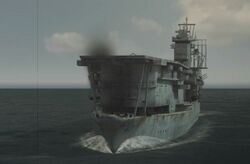 | |
| Armaments | AA Weapons: 5"/40 flak cannons x12, 25mm/60 machine guns x18 |
|---|---|
| Class | CV (Aircraft Carrier) |
| Speed | 20 knots |
| Strong against | Aircraft, PT boats |
| Weak against | Everything else |
There were only two carriers of the Akagi class. This is because they were originally built as battlecruisers, but were changed around. Like all carriers, sending this warship into direct combat is just asking for it to be sunk. It has absolutely no artillery armament, so it can't even return fire against an enemy destroyer. Its main weapon is, obviously, its wing of aircraft. One thing that is interesting to note about this carrier, though, is that it has slightly more armor then all of the other IJN carriers, so sending it in first on a map like operation MI may be a good idea.
The only two carriers of the Akagi class were the Akagi herself and the Kaga. The names are different from ships originally built as carriers (see the Soryu class below) since they were, as mentioned earlier, originally to be battlecruisers.
Official Description: The Akagi and the Kaga were the first large carriers to join the Imperial Fleet and have had long and distinguished careers. Originally built as battlecruisers, they were remodelled as carriers in the aftermath of the Treaty of Washington, which explains their unusual appearance. Both of these carriers served with great distinction in the Chinese campaign and together are known as Carrier Division 1. The Akagi is currently the flagship of Vice Admiral Nagumo's Carrier Striking Force.
Sōryū class[edit]
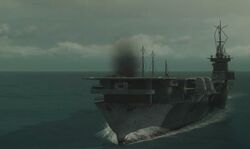 | |
| Armaments | AA Weapons: 5"/40 flak cannons x12, 25mm/60 machine guns x18 |
|---|---|
| Class | CV (Aircraft Carrier) |
| Speed | 20 knots |
| Strong against | Aircraft, PT boats |
| Weak against | Everything else |
Pretty much identical to the Akagi, the Sōryū has similar armaments and tactics. This carrier's profile is a little smaller than the Akagi's, so it stands a somewhat easier chance when attacked head-on, but really - putting a carrier into direct combat is worse than washing a computer with a garden hose.
Notable warships of this class include the pathfinder Sōryū, Hiryū,
Official Description: The Sōryū and her sister ship Hiryū were commissioned in the IJN in 1937, the first large carriers to join the Imperial Fleet since Akagi and Kaga were commissioned in the late '20s. The two Sōryū class ships were designated Carrier Division 2 and are currently part of the Kido Butai, the Carrier Striking Force commanded by Vice Admiral Chuichi Nagumo. As with all Japanese fleet carriers, they have a large number of fighter and strike aircraft aboard.
Type B class[edit]
Identical to the Narwhal-class in all respects, the Type B is a powerful if extremely slow warship. Her four frontal torpedo tubes allow her to easily send any warship lacking depth charges to the bottom. The only exception are PT boats, which are too shallow for torpedoes to connect. Use typical submarine tactics when commanding the Type B.
Official Description: The Type B is the most numerous and modern submarine design in service with the IJN. Only coming into service in 1940, these are fast, long-ranged ships, and every bit the match for the U.S. Narwhal-class subs. Like all submarines, they are very vulnerable when on the surface, thanks to their lack of armour and firepower - but submerged, they are a danger to any ship.
Type A Midget Submarine[edit]
The Type A, actually called the Ko-hyoteki class submarine but mislabelled in the official description as the "Mato", is a really small sub with a tiny torpedo complement. As a result of its small size it can be fried with even a glancing hit. If surfaced, it can even be struck with machine gun fire. Chances are, when you get to use one against the enemy fleet, it'll launch its torpedoes then get sunk. Even if it survives, it only has a max load of 4 torpedoes, so always make all these torpedoes count. The only map in which these subs are playable is Sibuyan Sea, where they are launched from a sub hangar. This makes Type As quite expendable.
The Type A might be small, but it has the fastest speed of any sub in the game both on the surface and submerged. Its quick speed and manoeuvrability earns it the nickname of "fighter sub", and it can evade destroyers attempting to sink it. Its only drawback is that it only carries four torpedoes which will quickly be expended. So, chances are the Type A will have a one way ticket only.
Official Description: The Type A minisub is a top-secret Japanese weapon. Codenamed the "Mato" ("Kato" in the official strategy guide) and built in 1938, its small size allows it to creep into enemy harbours and attack ships at anchor - something that would be difficult or impossible for a normal-sized submarine due to the shallow waters of most harbours. Armed with two torpedoes and manned by a two-man crew, this craft is potentially devastating in its dedicated role, but useless for any other kind of task.
Non-playable ships[edit]
These vessels are never controllable by the player. As a result, this guide takes an emphasis on destroying these targets rather than knowing how to captain them.
Minekaze-Class[edit]
You'll first encounter the Minekaze-class in Defence of the Phillipines, but it will mostly be preoccupied shelling your land bases instead of focusing on you. The first time you actually fight one is in the next mission, Running the Palawan Passage, during which the USS Kane engages the Hatsushimo.
The Minekaze-class is similar to the Clemson in practically every respect. Both warships are aged and venerable, and as a result do not sport much anti-aircraft armament. As destroyers, both support massive sonar suites, and both are more than capable of sending an enemy submarine to the bottom.
Notable warships of this class include the Harusame, Hatsushimo, Hayate, Natsugumo, Kasumi, and the Kawakaze.
Official Description: These ships were among the first to be completely designed and built by the Japanese, who had previously been using foreign designs and manufacturers, Entering the IJN as "first-class destroyers", the Minekaze-class are considerably outdated now and have many shortcomings, including the small number of guns they carry (which are open-mounted and have no armour protection) and very light AA armament. However, they do mount triple torpedo launchers, making them a dangerous proposition for any large ship.
Daihatsu[edit]
 | |
| Armaments | AA Weapons: 7.7mm machine gun x2 |
|---|---|
| Class | LCP (Personnel Landing Craft) |
| Speed | 25 knots |
| Strong against | Nothing |
| Weak against | Everything |
Extremely vulnerable to machine gun fire, these landing craft are small and swift, but nowhere near as fast as the American Higgins boats. Close into machine gun range and pepper them with machine gun fire to send these small, lightly armoured vessels to the bottom. Rarely will they ever counterattack, and even then they only have two tiny pea-shooters of guns, so don't expect much resistance.
Official Description: These flat-bottomed barges are similar in function to the Higgins boats used by the U.S Marine Corps and are used by the Japanese in amphibious assaults to land troops on enemy-held shores. They are light, fragile craft and are easily destroyed; however, their small size means that they are best targeted with machine gun fire. They carry a single machine gun, giving them only very rudimentary defence.
SB Boat Second Class[edit]
 | |
| Armaments | AA Weapons: 7.7mm machine gun x4 Artillery: 5"/50 cannon x2 |
|---|---|
| Class | LST (Vehicle Landing Ship) |
| Speed | 16 knots |
| Strong against | Machine guns |
| Weak against | Everything else |
These ships are designed to land armoured units. They're themselves armoured enough to resist machine gun fire, so you'll have to employ torpedoes or cannon fire to sink them. PT boats are your best bet - due to their small size, they can be difficult to hit with ship-launched torpedoes or artillery. With PT boats you can get in close and torpedo them at point-blank range. Fortunately all you need is one torpedo to send these large, slow targets down.
In later levels they attempt to employ artillery against you. All you have to do is counterattack with your own artillery. Their own artillery is of little threat to your destroyer, and rarely will they cause major damage to you. Nevertheless be careful when fighting them on Veteran difficulty, as they can do serious damage if they get a lucky hit (especially when there's a group of the like in Running the Palawan Passage). Like the Minekaze-class, they only become a real threat to your destroyer when playing on Veteran difficulty.
Three notable SB boats are the SB No. 102, SB No. 112 and SB No. 113, which are featured in the aforementioned mission, and will engage the player with their deck guns, they have the potential to cause serious damage to your Clemson-class destroyer.
Official Description: The Japanese military has never been shy about copying good ideas from elsewhere, and the SB boat is a prime example of this. Observing the efficacy of American LSTs at landing heavy material in amphibious assaults, the IJN rushed into producing their own design, with laterally opening bow doors. The SB mounts twin 5" guns on forward pivots, along with machine guns for defence, but it is far from being a combat vessel.
[edit]
The Naval Air Service doesn't have many planes, but the ones it does have are versatile and powerful, if lightly armoured.
Playable aircraft[edit]
Like the above ships, you'll only play as these either online or on the challenge missions. You will never play them in the single player campaign.
A6M Zero[edit]
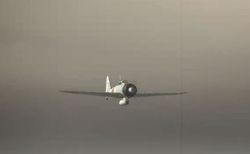 | |
| Armaments | 7.7mm machine guns x2 20mm autocannon x2 100kg bomb x1 (optional) |
|---|---|
| Strong against | Aircraft, PT Boats |
| Weak against | Ships |
The best fighter in the Second World War, it would later become hopelessly outdated with the creation of new USAF aircraft. For some odd reason though, in this game, the Wildcat is superior to the Zero in almost all respects; while the Zero causes slightly more damage with its machine guns, the Wildcat turns harder and climbs faster than the Zero. This does not mean, however, that Zeros are a sitting target.
The Zero may be unable to out-turn the Wildcat, but the Zero causes slightly more damage than the Wildcat and has better convergence of its guns. This makes the Zero a powerful B-17 killer. Its speed also allows it to out-run most other planes in the event things get ugly. Although the Zero is a poor fighter, the Zero is considered to be a better interceptor than the Wildcat is a fighter, so the Zero remains a powerful adversary and bomber interceptor.
Official Description: Known to the Imperial Japanese Navy as the "Type 0 Carrier Fighter", this is one of the finest planes currently serving in any air force. Capable of higher speeds than any comparable American plane and more manoeuvrable, it also boasts a hugely powerful armament of two 7.7mm machine guns and two 20mm cannons that fire explosive shells, giving it the power to shred any enemy in seconds. It has been in service since 1940 and is known to the allies by the codename "Zeke".
Ki-43 Oscar[edit]
 | |
| Armaments | 12.7mm machine guns x2 |
|---|---|
| Strong against | Aircraft, PT Boats |
| Weak against | Ships |
Comparable to both the Warhawk and the Buffalo, the Buffalo makes more appearances than the Warhawk, giving it the official Allied equivalent of this aircraft. This plane is actually not half-bad, with manoeuvrability and performance about the same as the Zero. Its main advantage is its twin nose-mounted guns, which makes them far easier to aim than the Zero's wing-mounted weapons.
The price is that they're easier to hit, being bigger targets - regardless, you'll have issues against them in the early levels, where Ki-43s are the ones harassing you and your PT boat.
Official Description: Where the Zero serves the Japanese Navy in the fighter role, the "Oscar" serves the Japanese Army. Known as the "Hayabusa" or "Peregrine falcon" to its pilots, it is a modern fighter aircraft that entered production in 1941. Although slightly slower than the Zero, it has a longer range, faster cruising speed, and a higher ceiling, making it better suited for land-based operation. Its only shortcoming is its offensive armament, which only consists of two machine guns. It is considerably undergunned compared to other fighters.
D3A Val[edit]
 | |
| Armaments | 7.7mm machine gun x2 500kg bomb x1 |
|---|---|
| Strong against | Destroyers, Light Cruisers, Land installations |
| Weak against | Flak cannons, fighters |
This dive bomber is comparable to the Dauntless, but it features a lighter bomb load. Its most redeeming factor is its manoeuvrability, which is pretty good for a dive bomber. Like the Oscar, it sports nose-mounted guns, making aiming a breeze with this plane. Like all bombers, it comes with a tail gunner which helps a little bit. The tail guns are most effective in groups, so always try to send these planes in groups of three or more.
Like the SBD Dauntless it can be used as a second-line fighter in an event such as all A6M Zeroes being lost.
Official Description: This carrier-based dive bomber is known by the codename "Val" to the allies, while the Japanese Navy terms it the Navy Type 99 Carrier Bomber Model 11". In service since 1939, it is instantly recognizable by its fixed landing gear - because it travels at lower speeds than fighter planes, a retractable gear is not necessary. It is a highly manoeuvrable and stable airplane indeed, it is so agile that it can serve as a dogfighter if necessary. It is very popular with the pilots of the Kido Butai, and in training they have achieved dive bombing accuracy statistics exceeding 80 percent.
D4Y Judy[edit]
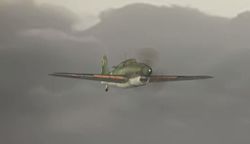 | |
| Armaments | 12.7mm machine guns x2 500kg bomb x1, depth charge x2 |
|---|---|
| Strong against | Ground targets, Destroyers, Light Cruisers, Submarines |
| Weak against | Flak cannons, fighters |
An upgraded version of the Val, the Judy can also double as an anti-submarine patrol plane, unlike its predecessor. Like all Japanese aircraft though, while it can dish out damage, it certainly can't take it.
Official Description: This carrier-borne dive bomber is scheduled to be introduced in 1942, to replace the "Val" on IJN Carriers. Prototyped in 1938, the "Suisei", or "Comet", as it is known to the Japanese, is a very advanced design indeed. Its speed is comparable to that of the "Zero" fighter while its bomb-bay and retractable landing gear both make for excellent aerodynamics. Normal armament is a single 500kg bomb, though depth charges can also be carried for anti-submarine work.
B5N Kate[edit]
 | |
| Armaments | 12.7mm machine guns x2 Aerial Torpedo x1, 500kg bomb x1 |
|---|---|
| Strong against | Ships, Ground targets |
| Weak against | Aircraft, machine guns |
The Allies have more types of torpedo bombers than the Japanese do, but that's okay - the Kate is a fine aircraft. It isn't the best in a dogfight, mainly due to its mobility, but it does have a rear-mounted machine gun turret that helps. Its guns are also nose-mounted, which helps. Follow typical torpedo bombing tactics when flying a Kate.
Although you can use it as a bomber, stick with torpedoes - equip those bombs on Vals instead. Kates are the only Japanese torpedo bomber (other torpedo bombers are converted level bombers - see below) so use them for what they're best at.
As with all torpedo planes its guns means it can be used as a fighter, but should only be deployed as one in worst-case scenarios, e.g. all fighters and dive bombers in your aircraft pool have been lost.
Official Description: Known to the Japanese as the "Type 97 Carrier Attack Bomber", this plane has been in service with the Imperial Japanese Navy as a torpedo bomber since 1939. Like the British Swordfish and the American Devastator, it is now considered obsolete and is due to be replaced by the B6N. It has seen combat in the Sino-Japanese War, where it was somewhat slow and poorly protected. As a result, it has received an engine modification. It is primarily used as a torpedo bomber but can also be equipped with a bomb load.
G3M Nell[edit]
 | |
| Armaments | 7.7mm machine guns x3 250kg bombs x6 or aerial torpedo x1 |
|---|---|
| Strong against | Ground targets, warships |
| Weak against | Anti-aircraft fire, fighters |
This bomber isn't bad, but there are obviously better ones out there. It's quite reasonably well-armed and, when launched in massive groups, can put the pressure on just about anything. It also doubles as a torpedo bomber, but given its massive size, it is much too easy to hit. You'll learn to appreciate Kates when you play Attack on Force Z. You'll also learn to appreciate the bomber's gunners in the same level.
Official Description: The first prototype for this twin-engine bomber flew in 1935, and it entered full production in 1936, making it a veritable pensioner in comparison to other modern bombers. Nevertheless, it is considered an excellent aircraft and is particularly notable for its long range: it was the first plane to perform a transoceanic attack when it was used to bomb mainland China during the Sino-Japanese War. However, it carries little defencive armament and is vulnerable to fighter attack.
G4M Betty[edit]
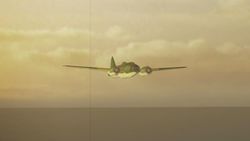 | |
| Armaments | 7.7mm machine guns x3 20mm machine guns x2 250kg bombs x12, aerial torpedo x1 |
|---|---|
| Strong against | Ground targets, warships |
| Weak against | Anti-aircraft fire, fighters |
Carries twice the number of bombs compared to the Nell, making the Betty indeed superior. Both, however, lack armour, and so both are easy prey for fighters. They also lack many weapons, so fighter escort is practically a must when it comes down to it.
Use the Betty over the Nell when it comes to bombing targets, since it is the one that has the bigger bomb load. Since both load one torpedo anyway, you are better off using the more expendable Nell for torpedo attacks when the situation demands it - but nothing beats a nice Kate in the air for a torpedo run.
Official Description: Known to the Allies by the callsign "Betty", this plane is nicknamed the "Hamaki", or "Cigar", to the Japanese servicemen, thanks to its cylindrical shape. It was commissioned in 1937, following the successful deployment of its predecessor, the Nell, in China. Very high specifications were set for the Betty in termsof top speed, altitude, and range. The result was an aircraft with very good performance. However, to achieve these specifications, it was necessary for the design team to make the plane very lightly armoured, making it very vulnerable to enemy fire.
J1N1 Gekko[edit]
 | |
| Armaments | 20mm machine gun x2 |
|---|---|
| Strong against | Aircraft |
| Weak against | Ships |
This plane handles like a fighter pilot's dream. Tied with the Lightning for the best turning and climbing rates, it even has nose-mounted weapons, thus saving the pilot from leading targets too much. It does have one major and glaring weakness, though: its size. Because it's so huge, almost as big as a bomber, it soaks up machine gun fire very easily, and it can't take damage at all. Regardless, against a Wildcat, you will immediately notice some solid advantages.
The only aircraft that can give it a run for its money is the American counterpart, the P-38 Lightning, which can be a pain due to its forked tail and smaller profile.
Official Description: Originally designed as a long range fighter to escort bombers, and capable of engaging single-engined fighters, the Gekko turned out to be too heavy for such a role, and was used as a reconnaissance plane first, and later converted into a night fighter. This twin-engined plane, shown here as the fighter variant, is a quick and agile fighter, best used to engage in head-to-head attacks, capable of quickly destroying unarmoured planes, thanks to the powerful, nose-mounted 20mm cannons.
Non-Playable Aircraft[edit]
Unfortunately, the Japanese don't have access to their flying boats at all.
H6K Mavis[edit]
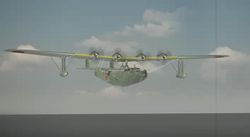 | |
| Armaments | 7.7mm machine guns x4 Aerial Torpedo x2, Depth Charge x2 |
|---|---|
| Strong against | Ships, Submarines |
| Weak against | Everything else |
Not at all comparable to the Catalina, the Mavis is big and slow, so it's a nice easy target for you to shoot down. Just evade its torpedoes and let your AA crew do the rest.
Official Description: This huge flying boat, with a wingspan 50% longer than the B-17 bomber, is considered an excellent transport and reconnaissance plane. Known to the Japanese as the "Type 97 Flying Boat", it can carry a payload of two torpedoes, a 2,205 lb bomb load, or 16 passengers. However, there are strong concerns over its suitability for frontline operations thanks to its very light armour and lack of self-sealing fuel tanks.
H8K Emily[edit]
 | |
| Armaments | 7.7mm machine guns x3 20mm machine guns x3 Aerial Torpedo x2, Depth Charges x2 |
|---|---|
| Strong against | Ships, Submarines |
| Weak against | Everything else |
This flying boat is more akin to the Catalina than the Mavis is. Unfortunately you'll never fly an Emily. Taking these out are a no-brainer - just lodge a bunch of bullets into their massive hulls, preferably with fighter planes. Interestingly, if you kill one while it's still on the water, the plane will sink like a ship.
Official Description: This new flying boat design entered service as a replacement for the H6K Mavis. Designed to be faster, longer ranged, and better defended than its predecessor, the Emily is thought to be the finest flying boat in service with any country. It is useful in a variety of roles and can be armed with torpedoes to attack shipping or with depth charges to attack submarines.
E13A Jake[edit]
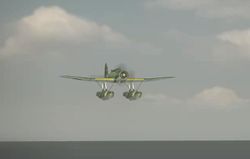 | |
| Armaments | 7.7mm machine gun x1 100kg bomb x1 (optional) |
|---|---|
| Strong against | Nothing |
| Weak against | Everything |
The Jake is a fine seaplane. However, it is still weak and is an easy target. It can be used as a fighter in emergency situations, but dogfighting is best left to dedicated fighters.
Official Description: This three-seater floatplane came into service and made its combat debut over China in the autumn of 1941. They are usually carried aboard cruisers or seaplane tenders, from which they are launched by a steam catapult. They are primarily used for reconnaissance, though they can play an antishipping role when armed with a 250kg bomb, which is effective against any small warship. They are easy meat for fighter planes, however, thanks to their slow speed, moor manoeuvrability, and very light defensive armament.
F1M Pete[edit]
 | |
| Armaments | 7.7mm machine guns x2 Depth Charges |
|---|---|
| Strong against | Submarines |
| Weak against | Everything else |
A recon plane that is actually quite good at recon and as a primative dogfighter.
These planes are even weaker than the Jakes. A ship's anti-aircraft battery should manage to take these out by themselves. In a worst case scenario, send up a single Wildcat to take them out.
In the first submarine challenge mission, these planes get equipped with depth charges that make them deadly against submarines.
Official Description: Although designed in 1935, this two-seater biplane didn't enter service until 1941, making it one of the very few biplanes in active service with an country in WW2. Nevertheless, it is a remarkable able aircraft with a fine turn of speed for a biplane and exceptional manoeuvrability. Designed to be launched from a ship for a short-range observational role, it has also shown itself to be an adept dive bomber and has even served in the fighter capacity.
